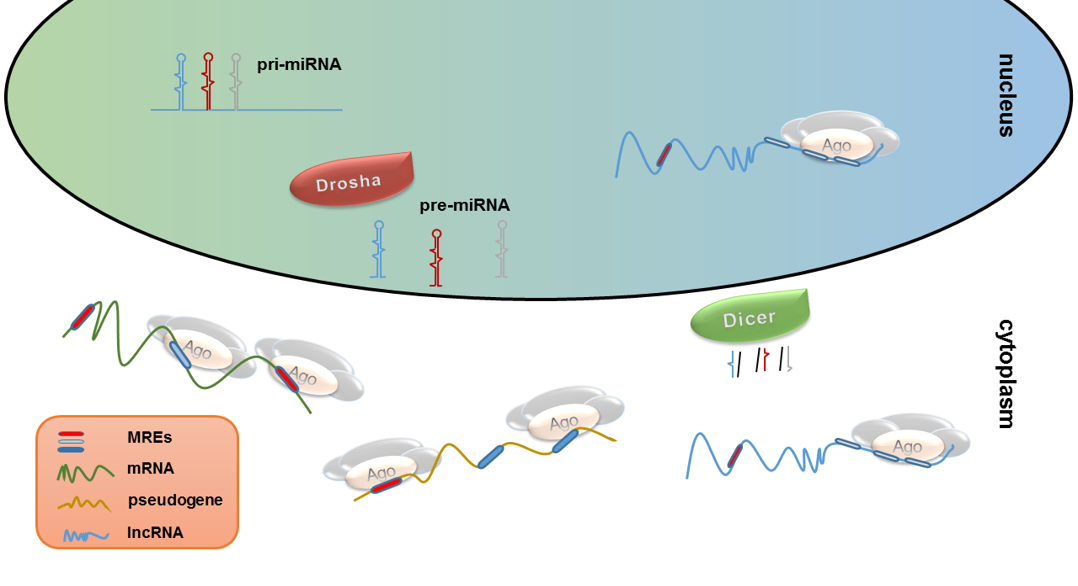MicroRNA research has emerged as a groundbreaking field, illuminating the intricate mechanisms of gene regulation critical for understanding various biological processes. Pioneered by Nobel laureate Gary Ruvkun in the early 90s, these small non-coding RNA molecules were discovered in the model organism C. elegans, sparking a revolution in molecular biology. Their roles extend beyond basic research; microRNAs are now integral to developing innovative therapies for diseases such as cancer and Alzheimer’s, indicating their profound importance in modern medicine. The journey from discovery to the anticipated Nobel Prize 2024 is a testament to the enduring impact of federal funding for science that has supported decades of research. As interest in this field continues to expand, the significance of microRNA in gene expression and regulatory pathways gains ever more recognition.
Exploring the realm of small regulatory molecules, microRNA (miRNA) research is reshaping our understanding of genetic control and its implications for health. These tiny strands of RNA act as critical regulators, influencing how genes are expressed and proteins are produced within cells. The initial work of Gary Ruvkun not only spotlighted their existence in the roundworm C. elegans but also opened doors to novel therapeutic approaches targeting various diseases. As advancements in miRNA technology continue, the potential applications in medicine and beyond are vast, demonstrating the importance of sustained investment in scientific inquiry. Additionally, recognizing the role of these molecules in gene silencing has garnered increased attention from researchers and funding bodies alike, highlighting the pivotal nature of this innovative research.
The Breakthrough of MicroRNA Research
The groundbreaking discovery of microRNA by Gary Ruvkun and Victor Ambros in 1992 marked a significant shift in our understanding of gene regulation. This small RNA molecule, essential for the regulation of genes in organisms including the C. elegans roundworm, has become a focal point of molecular biology and genetics. Ruvkun’s assertion that they were merely average researchers at the time juxtaposes the unexpected impact their findings would eventually hold, particularly as they earned the Nobel Prize in 2024. The subsequent exploration of microRNAs has revealed their pivotal roles in various biological processes, extending far beyond what was initially recognized.
MicroRNA research has evolved dramatically since its inception, with its implications reaching across multiple disciplines within biological sciences. Initially overlooked by many evolutionary biologists, the enthusiasm surrounding microRNA has since surged, spurring a wave of interest from researchers worldwide. The realization that these tiny RNA molecules are not just limited to C. elegans, but are also prevalent and crucial in humans and other species, highlights their universal significance in gene regulation. As clinical trials for microRNA-based therapies for diseases like cancer and heart conditions progress, it is evident that microRNA has transformed into a cornerstone of modern genetic research.
Gary Ruvkun’s Journey to the Nobel Prize 2024
Gary Ruvkun’s journey from a relatively unrecognized researcher to a Nobel laureate encapsulates the often tumultuous nature of scientific discovery. Back in 1992, the notion that microRNA could play a fundamental role in gene regulation was met with skepticism. It was only through perseverance, and steady support mostly from federal funding like NIH grants, that Ruvkun and Ambros were able to validate their findings. The decade-long journey culminated in the 2024 Nobel Prize in Physiology or Medicine, recognizing the profound implications of their work on microRNAs.
This recognition not only celebrates their scientific achievement but also underscores the importance of sustained federal funding in research. Ruvkun’s experiences serve as a compelling reminder of how essential public support can be in fostering groundbreaking research. With the potential threat of funding cuts looming over the scientific community, Ruvkun’s story emphasizes the critical need for ongoing investment in research initiatives that have demonstrated their ability to advance not only our understanding of biology but also the development of life-saving medical therapies.
Decades of federally funded breakthroughs have significantly advanced the field of genetics, further validating the investment in fundamental research. Ruvkun’s lab has benefited from nearly 40 years of continuous federal support, which he argues is not wasteful but a vital investment in the future of medical science. As funding allows for the exploration of uncharted territories in biology, the results can lead to transformative therapies for conditions that plague millions—a clear sign of the power and potential of microRNA research.
Impact of Federal Funding on Scientific Advancement
The trajectory of Gary Ruvkun’s research into microRNAs illustrates the profound impact that federal funding has on scientific advancement. Over the years, Ruvkun has relied on federal grants to support a small team dedicated to exploring the intricacies of gene regulation. This reliance on public funding highlights the essential role that governmental investment plays in nurturing innovative research, fostering a robust scientific community, and driving forward discoveries that can lead to transformative medical breakthroughs. Without such financial backing, the chances of uncovering significant findings, like those of microRNAs, could have drastically diminished.
In a climate where federal funding for science faces scrutiny and potential cuts, Ruvkun’s reflections on his lab’s successes underline the importance of maintaining robust support for research initiatives. He emphasizes that the work done in scientific labs is not only essential for academic inquiry but is also foundational to industry advances in biotechnology and therapeutics. The presence of companies like Alnylam, which have sprung from academic research, demonstrates the cyclical relationship between funding, research, and economic growth, marking how integral federal investment has been in creating a thriving innovation ecosystem.
The Role of MicroRNAs in Modern Medicine
MicroRNAs have emerged as crucial players in the development of novel therapies aimed at complex diseases. Their ability to regulate gene expression at a post-transcriptional level has paved the way for innovative treatment methodologies targeting ailments such as cancer, Alzheimer’s, and cardiovascular diseases. As outlined in ongoing clinical trials, therapies leveraging the regulatory functions of microRNAs may provide new hope for conditions that have long eluded effective treatment. The medical community’s excitement about microRNA promises highlights their potential not only to revolutionize existing treatments but also to enhance preventative care strategies.
Research into microRNAs has expanded rapidly, unveiling links between these regulators and various health conditions, spurring further investigation into their therapeutic applications. By understanding how microRNAs influence biological processes, scientists can develop targeted interventions that modify gene expression selectively. This precision medicine approach is particularly appealing in an era where customization of healthcare is becoming standard. As the field continues to evolve, the integration of findings from microRNA research into clinical practice will likely define the future of medical therapy.
The Evolution of RNA Research
Over the past few decades, RNA research has undergone a remarkable evolution, transitioning from a niche area of study into a leading frontier of genetic science. The foundational work on microRNA by Ruvkun and Ambros sparked a broader interest in RNA molecules and their multifaceted roles within cellular processes. Scientists now recognize not only the regulatory functions of microRNAs but also their implications in disease pathology and treatment. Consequently, this has led to an exponential increase in the number of researchers and studies focused on RNA, reflecting a burgeoning field that intersects with numerous scientific disciplines.
This expansion has fostered collaborations across various fields, creating a diverse research environment where cross-pollination of ideas can thrive. As more scientists dive into RNA research, the foundational discoveries made by early pioneers like Ruvkun are continuously built upon, leading to innovative technological advancements and therapeutic strategies. The collaborative energy within the RNA research community is vibrant, highlighting the importance of shared knowledge in driving scientific progress, and fostering breakthroughs that will have lasting impacts on medicine and biology.
The Future of Gene Regulation Research
As we look ahead, the future of gene regulation research appears bright, particularly with the growing excitement surrounding microRNA and its implications. The prevailing understanding of genetics is shifting dramatically as researchers uncover the intricate web of interactions that dictate gene expression, protein synthesis, and, consequently, the development of diseases. Emerging technologies such as CRISPR and RNA interference are poised to enhance our capabilities in manipulating gene expression, paving the way for novel therapeutic approaches that may revolutionize treatments for hereditary conditions and chronic diseases alike.
Furthermore, with the increasing recognition of gene regulation’s complexity, future research directions are likely to focus more significantly on the interplay between various regulatory molecules, including microRNAs, long non-coding RNAs, and other epigenetic factors. As we unravel these connections in the context of entire biological systems rather than isolated pathways, the potential for transformative discoveries will expand. Integration of advancements in genomics and bioinformatics will facilitate deeper insights into gene regulation dynamics, ultimately propelling forward our understanding of health and disease.
Challenges and Opportunities in Molecular Biology
The field of molecular biology, specifically in the study of gene regulation, faces significant challenges, including funding constraints, public interest fluctuations, and the sheer complexity of biological systems. As highlighted by Gary Ruvkun’s concerns, the future of scientific research hangs in the balance of federal funding initiatives, which can make or break innovative projects. The potential for declining support could dissuade young scientists from pursuing careers in the field, ultimately hindering progress and discovery crucial for advancing medical science.
However, within these challenges lie tremendous opportunities for innovation and collaboration. The increasing integration of molecular biology with technology-driven fields such as artificial intelligence and data science presents a unique avenue for enhancing research efficacy and problem-solving capabilities. By fostering interdisciplinary approaches and encouraging academic-industry partnerships, the molecular biology community can navigate funding challenges while accelerating advancements in therapeutic development and improving overall public health outcomes.
The Significance of Basic Research
Gary Ruvkun’s work exemplifies the transformative power of basic scientific research, which often serves as the foundation for applied sciences and technological innovations. The knowledge gained from fundamental studies into microRNAs not only propelled Ruvkun to the Nobel Prize in 2024 but has also led to new therapeutic strategies that impact millions. This underscores the critical importance of sustaining support for long-term research endeavors that may not yield immediate results but are essential for future scientific breakthroughs.
A strong commitment to basic research ensures that scientists can explore ‘blue sky’ ideas without the constraints of immediate commercialization pressures. Ruvkun’s experience shows that fundamental discoveries often lead to untapped potential for medical advancements, such as those seen in RNA therapeutics. Thus, advocating for robust funding and support for basic research is not just a scientific priority; it’s a societal imperative that can foster innovation, enhance public health, and drive economic growth.
Frequently Asked Questions
What is the significance of microRNA research in modern genetics?
MicroRNA research has emerged as a pivotal area in genetics, especially following groundbreaking discoveries by Gary Ruvkun and Victor Ambros in 1992. Their innovative findings revealed a new level of gene regulation, particularly in the C. elegans model organism, paving the way for understanding gene functions across various species, including humans. This research underpins crucial therapeutic developments targeting diseases such as cancer and Alzheimer’s.
How did Gary Ruvkun’s research on microRNA lead to the 2024 Nobel Prize?
Gary Ruvkun, alongside Victor Ambros, was awarded the 2024 Nobel Prize for their pioneering work in microRNA research. Their initial discovery in 1992 demonstrated that microRNAs play a significant role in gene regulation. This foundational research has since contributed to advanced therapies and a deeper understanding of gene expression mechanisms, illustrating their impact on modern medicine and genetics.
What role does federal funding play in advancing microRNA research?
Federal funding, primarily from the National Institutes of Health (NIH), has been instrumental in advancing microRNA research. Gary Ruvkun highlighted that much of his work has been supported by federal grants, which facilitated long-term studies and breakthroughs in gene regulation. This financial support is critical for sustaining research that leads to significant medical advancements and innovations in genetic therapies.
How are therapies based on microRNA being utilized in clinical trials?
Therapies based on microRNA are currently under investigation in various clinical trials aimed at treating conditions such as heart disease, cancer, Crohn’s Disease, and Alzheimer’s. This research stemmed from foundational work in microRNA regulation and aims to leverage these tiny RNA molecules’ capabilities to develop novel treatments, transforming patient outcomes in modern medicine.
What is the importance of microRNAs in the human genome?
MicroRNAs are crucial components of the human genome, with approximately 1,000 microRNAs identified that regulate a majority of protein-coding genes. Their role in gene regulation has profound implications for developmental biology and the treatment of diseases. Increased understanding from microRNA research leads to potential therapeutic strategies to manipulate gene expression, addressing a wide range of health issues.
How did Gary Ruvkun’s findings impact the scientific community’s view of microRNAs?
Initially, Gary Ruvkun’s findings on microRNAs were met with skepticism in the evolutionary biology community. However, as research progressed, it became evident that microRNAs serve essential functions beyond the C. elegans model, stimulating widespread interest and collaboration among scientists across various fields. This shift marked a recognition of microRNAs’ significance in gene regulation and their applications in medicine.
What future challenges does microRNA research face regarding funding and scientific careers?
MicroRNA research faces challenges related to securing continued federal funding, which is vital for sustaining innovative studies and retaining young scientists in the field. Gary Ruvkun expressed concerns about diminishing financial support potentially driving emerging researchers to seek opportunities abroad, thereby impacting the future landscape of scientific research in the United States.
| Key Points | Details |
|---|---|
| Discovery of microRNA | Gary Ruvkun and Victor Ambros discovered microRNA in 1992, which led to their recognition with the 2024 Nobel Prize. |
| Initial Reception | Initially, the evolutionary biology community did not see the significance of their findings. |
| Funding and Support | The research was primarily funded by NIH grants, which supported the gradual increase in interest within the RNA research community. |
| Clinical Applications | MicroRNA therapies are currently being tested in clinical trials to treat various diseases like cancer and heart disease. |
| Impact on the Workforce | Ruvkun expresses concern over federal funding cuts, emphasizing their importance for sustaining scientific careers in the U.S. |
| Economic Contributions | Ruvkun highlights the role of federal funding in shaping successful companies, like Alnylam, in the biotech industry. |
Summary
MicroRNA research has transformed our understanding of gene regulation, news that has garnered significant attention in recent years. The groundbreaking discoveries by Gary Ruvkun and Victor Ambros have laid the foundation for developing therapies that target a range of ailments, including cancer and heart disease. As funding and interest in this field grow, the potential of microRNAs continues to expand, underlining their critical role in both scientific research and medical advancements. Ensuring continued investment in microRNA research is essential for maintaining the momentum and addressing pressing health challenges.








